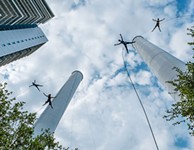Impermanence
This aerial dance enlarges your heart, your field of vision, your brain capacity
Reviewed by Jonelle Seitz, Fri., June 26, 2009
Impermanence
J.J. Pickle Federal Building, through June 28
Running time: 1 hr
In the middle of Blue Lapis Light's Impermanence, three dancers, harnessed, tethered, and impossibly perpendicular to the side of the fourth story of the J.J. Pickle Federal Building, interpret the high notes of the soprano voice in Brahms' A German Requiem with soaring backflips, their legs wonderfully stretched in the air, their backs arched. I became mesmerized by the surreality of those star-pointed bodies swirling in the black. Through art and artifice, they had attained a release from gravity, freeing themselves to rise, stretch, release, and waver with the music without hopelessly falling back to earth. I thought of the 19th century ballerinas who first hoisted themselves on wires and rose to the tips of their toes to make their sylphs and ghosts seem more ethereal. And then, I was crying.
I didn't expect this. Impermanence was my introduction to director Sally Jacques' work, and my previous experiences with aerial dance involved folks doing a lot of spinning in their harnesses and trapezes, with little attention to music or purpose. But here there is no spinning, and the apparatus isn't the point. Jacques' dancers are gorgeous, finely trained artists. They are so skilled and well rehearsed that they are able to move not just safely, exquisitely, and in unison when the choreography requires but in complete alliance with the mixed score and the emotional purpose of the show.
Jacques works on a vast scale and has assembled a team of fellow big-thinkers to help carry out her vision. The work involves seven dancers working with three types of gear as well as five rappellers who round out the cast and scale the 11-story building. The contributions of lighting designer Jason Amato, costume designer Sachi DeCou, and sound designer William Meadows are immeasurable and make the production a spectacle of wonder from several angles.
In one section, dancers work with four-story-high lengths of white cloth, moving to the richly meditative vocals of Tina Marsh, a longtime collaborator of Jacques' who died of cancer just days before the production opened and to whom Impermanence is dedicated. By climbing the cloth and wrapping it around their bodies, the dancers at once bind and free themselves to stretch their bodies into poses, some Christlike, others borrowed from ballet and yoga, and still others organic and spiral. In a duet with the cloth, two dancers pair strength and control with expressivity as they grasp, balance, and slide their bodies past each other.
One element that makes the show so striking is the vulnerability of the performers, which is apparent when the dancers first begin to climb the cloth, without harnesses or safety nets: There is nothing between their precious dancer flesh and the brick plaza but four stories of air. And while the placement of the work in an outdoor site suggests that the "theatre" is interminable, the lighting and staging give the impression that beyond the performance itself is a void of black, artless night. Though the apparatus limits how far the movers can travel and lends itself to repetition, I did not tire of, for example, the series of backflips on the wall. Instead, I reveled in them and meditated on the impermanence of it all.
Within a loosely narrative structure, the characters are angelic or portray souls in an area of meeting between worlds, the earthly and the heavenly, if you please. They meet, then one stays behind or moves on to a different place. The connection to Marsh's death is tangible, and the work is a beautiful tribute. It's also a wonderfully experiential work that, as you're witnessing it, enlarges your heart, your field of vision, your brain capacity. But, at least for me, this enlightenment is fleeting. As Jacques reminds in the program, "Dance is the quintessential expression of impermanence." When the show closes, it will cease to exist. And, heartbreakingly, my memory's best-conjured image of the three dancers somersaulting through the night on the building side is already faint and static.











